 |
|||||||||||||
| A complete professional service for drains, water pipes and sewage systems | |||||||||||||
 |
|||||||||||||
| Call 01752 395038 or 0786 270 6627 | Email: info@draintechsw.co.uk | ||||||||||||
|
Septic Tank and Soakaway Systems With backgrounds in construction, drainage and plumbing, the DrainTech South West team has particular strengths and experience in the installation, repair and maintenance of septic tanks, sewage treatment plants and soakaways. Where a property is not connected to mains sewerage, waste water from the kitchen sink, washing machine, shower and bath - and effluent from the toilet - is often piped into an underground septic tank. (Alternative systems are older sealed cesspools, designed to store effluent until it can be pumped away but seldom used today, and sewage treatment plants.)
A pipe leaves the septic tank carrying the liquid effluent - which will still contain a small proportion of solid material - into a soakaway system. It is vitally important that a septic tank is emptied once a year, to remove the solids which build up at the bottom of the tank. When considering the location for a septic tank, the Building Regulations state that "Septic Tanks should be sited at least 7m from any habitable parts of the buildings, and preferably downslope."
Potential
septic tank problems: Problems are often due to a breakdown in the soakaway system. A soakaway may rapidly become blocked if a septic tank is not efficiently separating solid from liquid waste. Overflow: Your septic tank needs to be of the right size and style to meet the needs of the sewage outflow your property is producing. If it is too small, it will have a major impact on the efficiency of the soakaway system. Modern households use much more water - with the spread of dishwashers, washing machines and en-suite toilet and shower facilities - so older septic tanks may no longer be able to cope with the flow. The Building Regulations state that "Septic tanks should have a capacity below the level of the invert of at least 2,700 litres for up to 4 users. The size should be increased by 180 litres per additional user." To find out more, read the Code of Practice from British Water - "Flows and Loads" - click here. Contact us for advice on the correct size of tank or treatment plant to suit your needs. Smell: Other problems: Liquid grease in kitchen waste water cools and solidifies, and can narrow or block drainage pipes. This can be avoided by installing a grease trap near the kitchen outlet to filer out liquid greases. The Trap must be regularly emptied. If effluent leaving a septic tank has not been sufficiently cleared of solid matter and is causing problems, it is sometimes possible to avoid the expense of replacing the tank or installing a new treatment plant by fitting a secondary treatment system to the outflow from the tank. Contact us for more information.
More information: Soakaway
systems The septic effluent leaving the septic tank is composed of liquid sewage with a low solids concentration. The soakaway disperses this into the subsoil where natural processes complete the breakdown of the sewage. Soakaways are often constructed of long trench lines filled with clean stone, through which the effluent is distributed along a slotted or holed pipe. Modern soakaway systems may use plastic modular cells ("Aquacells") in place of cleaned stone. The size of soakaway system required depends on the number of residents the system is serving, whether it is connected to a septic tank or treatment plant, and on the porosity of the sub soil. This is determined by a porosity test, which involves digging test pits and filling them with water. Based on the average time these take to empty, it is possible to calculate the permeability of the soil and the size of soakaway required. For more information about the size of the system required, read the Code of Practice from British Water - "Flows and Loads" - click here. If the level of the natural water table in the area rises above the base of the soakaway system, its operation may be much reduced. In these cases, an effluent pump system may help to solve the problem - contact us for more information. Whatever the size of your septic tank and soakaway project, DrainTech South West are ready to help.
Rainwater soakaways:
If the soakaways become blocked - for example, clogged with tree or
shrub roots if With concerns about climate change, and rising water prices, rainwater harvesting and recycling systems are becoming more common. Contact us for more information. For information about waste water treatment plants, click here.
We are specialists in providing solutions for our clients' problems with septic tanks, soakaways and waste treatment plants, serving a wide area, including Tavstock, Okehampton, Plymouth, Ivybridge, Buckfastleigh, South Brent, Brixton, Noss Mayo,Newton Ferrers, Yealmpton, Callington, Launceston and Liskeard.
|
|||||||||||||
|
Home | Drain Repairs | No dig solutions | Treatment Plants & Septic Tanks | Stormwater | Groundwork | Leaks & Blockages Website design by Graphic Words (01822 810511) |
|||||||||||||
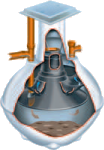 A
septic tank uses natural anaerobic bacterial action, combined
with gravity, to remove as much of the solid waste as possible from
the effluent. Septic tanks are designed to slow down the flow of the
sewage to allow this to happen. Modern tanks are resin-moulded and very
efficiently use internal baffles to slow the flow and allow the solid
waste to drop out.
A
septic tank uses natural anaerobic bacterial action, combined
with gravity, to remove as much of the solid waste as possible from
the effluent. Septic tanks are designed to slow down the flow of the
sewage to allow this to happen. Modern tanks are resin-moulded and very
efficiently use internal baffles to slow the flow and allow the solid
waste to drop out.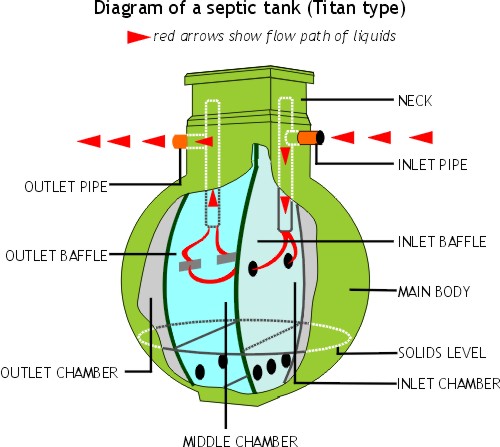
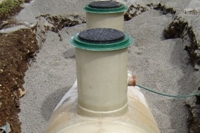
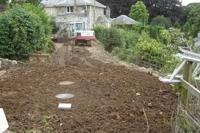
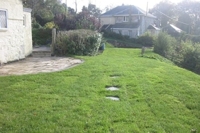
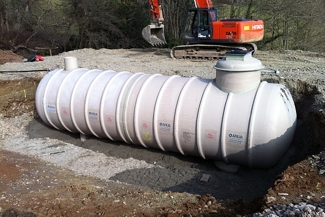
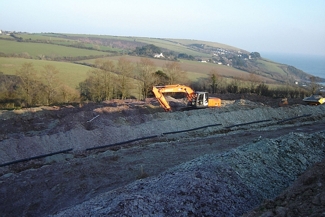
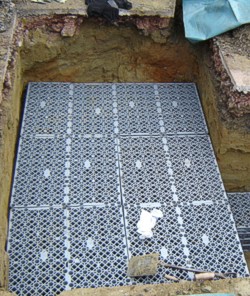 Rainwater
soakaways are usually large pits filled with open stone, although modern
soakaways often use modular plastic "Aquacells". A typical
domestic house requires a rainwater soakaway of about one cubic meter.
Rainwater
soakaways are usually large pits filled with open stone, although modern
soakaways often use modular plastic "Aquacells". A typical
domestic house requires a rainwater soakaway of about one cubic meter.